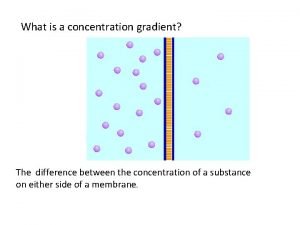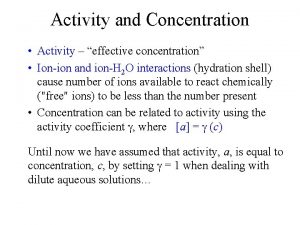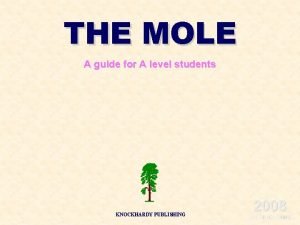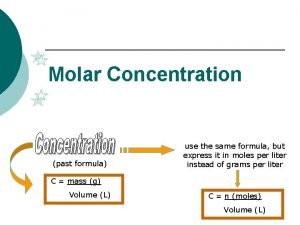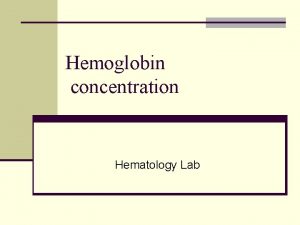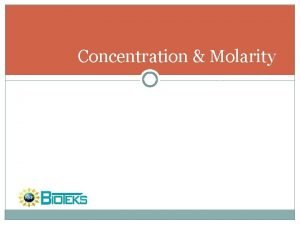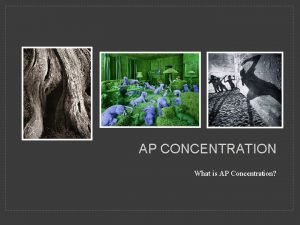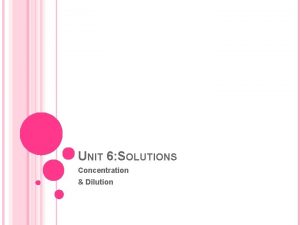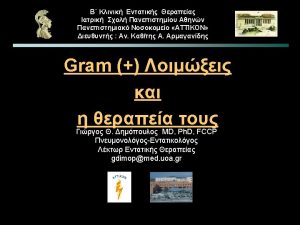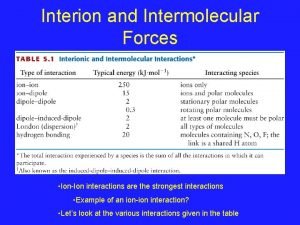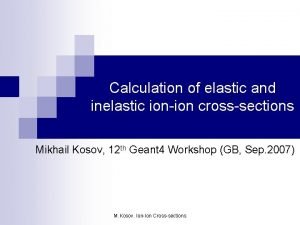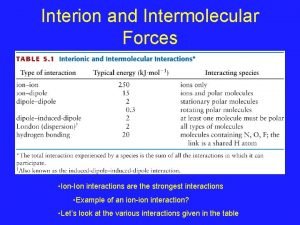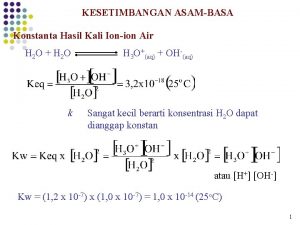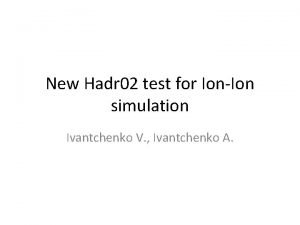Activity and Concentration Activity effective concentration Ionion and












- Slides: 12

Activity and Concentration • Activity – “effective concentration” • Ion-ion and ion-H 2 O interactions (hydration shell) cause number of ions available to react chemically ("free" ions) to be less than the number present • Concentration can be related to activity using the activity coefficient g, where [a] = g (c) Until now we have assumed that activity, a, is equal to concentration, c, by setting g = 1 when dealing with dilute aqueous solutions…

But ions don’t behave ideally. . . • Concentration related to activity using the activity coefficient g, where [a] = g (c) • The value of g depends on: – Concentration of ions and charge in the solution – Charge of the ion – Diameter of the ion • Ionic strength, I = concentration of ions and charge in solution I = 1/2 Smizi 2 – where mi = concentration of each ion in moles per L, zi = charge of ion • Activity coefficient gz 1 as concentrations 0 and tend to be <1 except for brines

Calculation of Ionic Strength I = 1/2 Smizi 2 I = 0. 5[(HCO 3–)· 12 + (SO 42–)· 22 + (Cl–)· 12 + (NO 3–)· 12 + (Ca 2+)· 22 + (Mg 2+)· 22 + (Na+)· 12 + (K-)· 12 + (Fe 2+)· 22 + (Si. O 2)· 02] Substituting values for Lake Superior I = 0. 5(0. 00082· 12 + 0. 00005· 22 + 0. 00004· 12 + 0. 000008· 12 + 0. 00035· 22 + 0. 00013· 12 + 0. 00001· 12 + 0. 000006· 22 + 0. 00007· 02) I = 0. 0016 — How does this value compare with other natural waters? 0. 001 - 0. 005 0. 001 - 0. 02 0. 7 >5

Sources for ions in natural waters?

Seawater Rivers, lakes, groundwater Brines Na+ gi Ca 2+ SO 42 I (from Garrels and Christ, 1965)

Solution Models • Debye-Hückel Equation Physical model based on electrostatic interactions • At higher ionic strength, use extended Debye-Hückel equation • Davies Equation for higher ionic strengths (<0. 5) where I is the ionic strength of the solution as defined above; z is the charge of the ion whose activity coefficient is being calculated; A and B are constants whose values depend on the dielectric constant of the solvent and the temperature; and a is the effective diameter of the ion in the solution in Å.

Debye. Hückel Extended Debye-Hückel Davies I < 5 x 10 -3 I < 0. 1 x 10 -3 I ≤ 0. 5 Davies Debye-Hückel Extended Debye-Hückel Fig. 2 -2. Variation of the activity cofficient for Ca 2+ according to the three forms of the Debye-Hückel equation (Drever, 1997)

Diagenesis and the growth of concretions Diagenesis includes all of the chemical, physical, and biological processes that take place in sediment after it was deposited: Chemical processes: dissolution of minerals in pore water, precipitation of insoluble compounds, and ion exchange reactions between aqueous species and the surfaces of solids Biological processes: bioturbation, bacteria-driven chemical reactions (reduction of sulfate), biogenic compounds may inhibit dissolution of minerals by coating grain surfaces or enhance dissolution by adsorbing ions Physical processes: deposition, compaction, flow of pore water…

The growth of concretions during diagenesis Minerals may precipitate from pore water of sediment within pore spaces as a cement or replace pre-existing minerals that dissolve, both of which may cause the formation of concretions Growth of a concretion with a radius of rc by diagenetic redistribution caused by dissolution of a mineral in the sediment, diffusion of the resulting ions to the surface of the concretion, and precipitation of a new mineral in the pore spaces of the sediment. The process is transport-dominated and causes the formation of a depleted zone with a radius rd and a width L. Dc (=cd-cp) is the molar concentration of the material that is dissolving (cd) and precipitating (cp), and F is the flux of ions to the surface of the concretion and leaving the outer surface of the depleted zone. From Faure chapter 15 — “Rates of Geochemical Processes”

Calcite concretion Sandstone concretion Calcite concretion (coated with hematite) Sandstone concretion

So what about rates? Calculate the time required for a calcite concretion to grow by dissolution of disseminated aragonite and diffusion of the resulting Ca 2+ ions at 10°C? t= rc 2 2 Vp. DDc ( ) f -1 fd What you are given: rc, radius of the concretion = 8. 0 cm D, the diffusion coefficient = 5. 4 x 10 -6 cm 2/sec f, porosity = 0. 75 fd, volume fraction of aragonite in the sediment = 0. 15 Dc, difference in equilibrium concentration of Ca 2+ in pore water on the surfaces of calcite and aragonite = 2. 0 x 10 -5 mol/kg Vp, volume of calcite = 36. 934 cm 3/mol

So what about rates? Calculate the time required for a calcite concretion to grow by dissolution of disseminated aragonite and diffusion of the resulting Ca 2+ ions at 10°C? t= (8 cm)2 ( 3 2 cm cm -6 2(36. 934 mol )(5. 4 x 10 sec )(2 x 10 -5 mol kg ) 0. 75 0. 15 -1 ) t = 8. 022 x 109 sec • 1000 ÷ 3. 154 x 107 sec/year = 254, 386 years rc, radius of the concretion = 8. 0 cm D, the diffusion coefficient = 5. 4 x 10 -6 cm 2/sec (T dependent) f, porosity = 0. 75 fd, volume fraction of aragonite in the sediment = 0. 15 Dc, difference in equilibrium concentration of Ca 2+ in pore water on the surfaces of calcite and aragonite = 2. 0 x 10 -5 mol/kg Vp, volume of calcite = 36. 934 cm 3/mol
 Concentration gradient vs concentration difference
Concentration gradient vs concentration difference Movement of high concentration to low concentration
Movement of high concentration to low concentration Activity concentration
Activity concentration Activity coefficient
Activity coefficient Reactants, products and leftovers
Reactants, products and leftovers Diagram aoa
Diagram aoa Activity 1 introductory activity
Activity 1 introductory activity Activity 2 finding the sequence
Activity 2 finding the sequence 3
3 Activity 2
Activity 2 Conc moles volume
Conc moles volume Converting grams to moles
Converting grams to moles Molarity is defined as
Molarity is defined as
